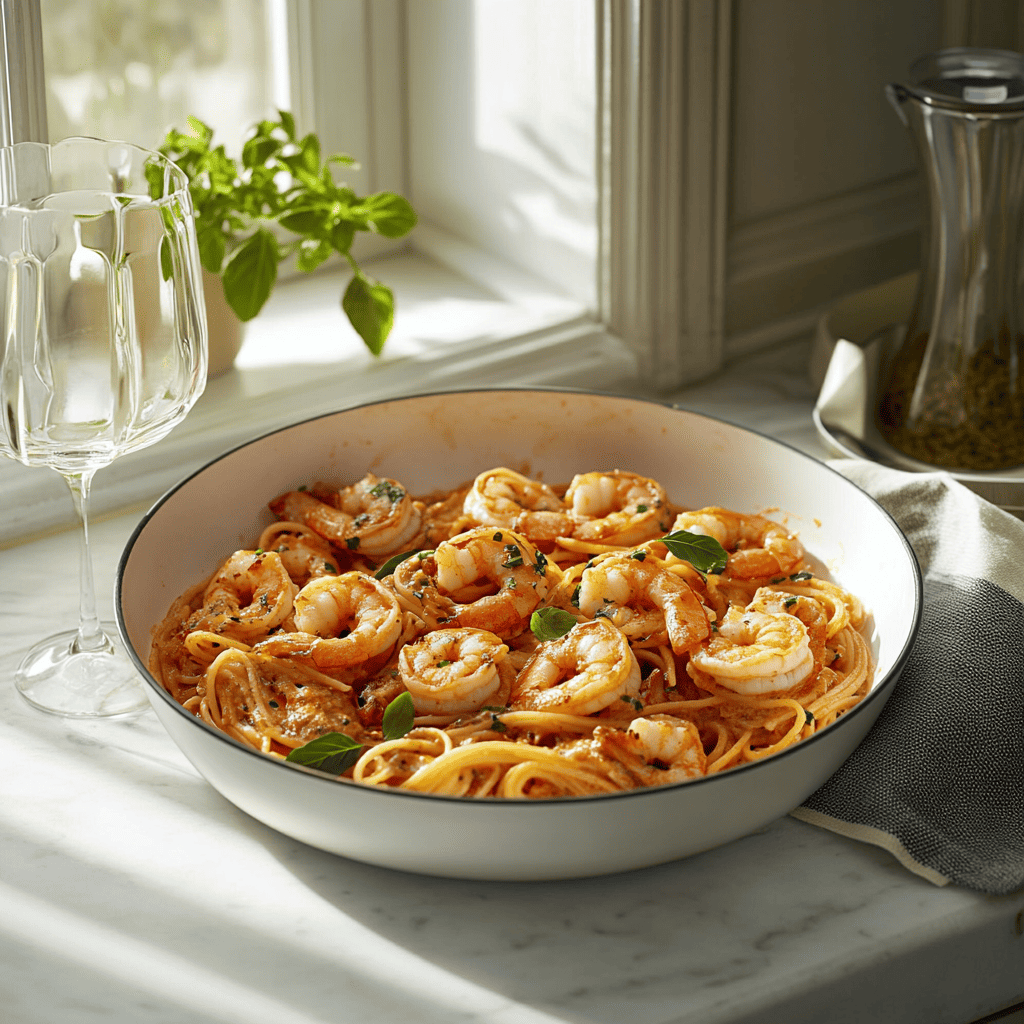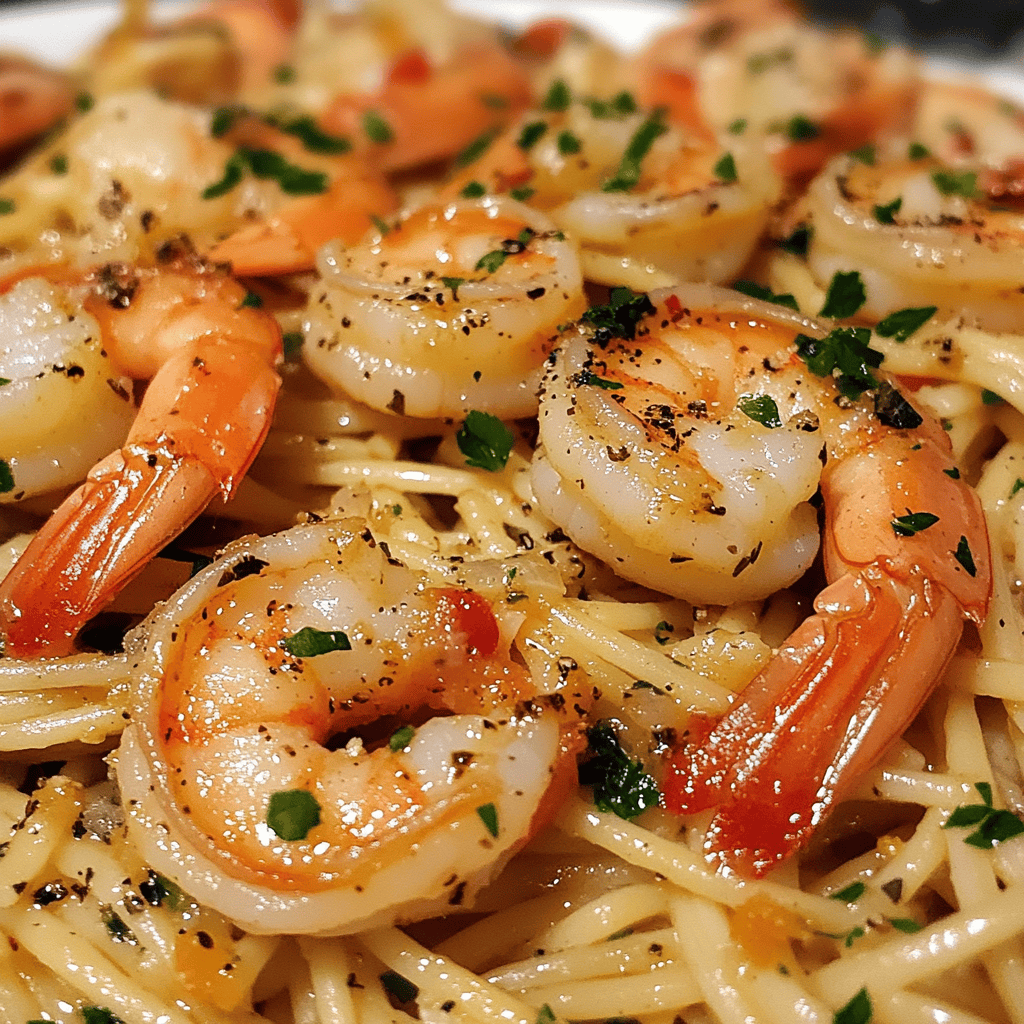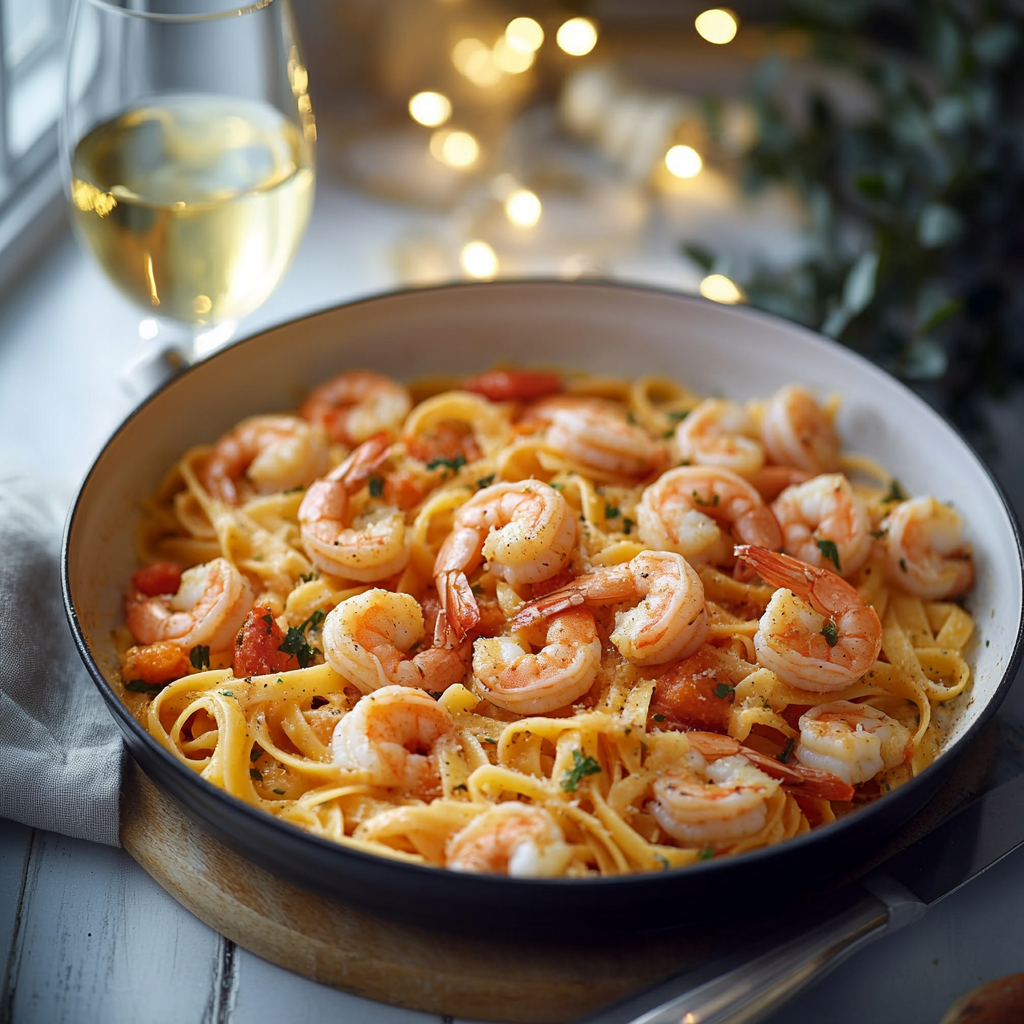Quick Overview
If you’re searching for a delightful and quick meal that’s sure to impress, look no further than this shrimp pasta recipe. In just under 30 minutes, you can create a dish that bursts with flavor and offers a satisfying experience. Ideal for busy weeknights or special occasions, this dish combines succulent shrimp with perfectly cooked pasta and a variety of fresh ingredients. The simplicity of this recipe makes it accessible for cooks of all skill levels. Plus, it’s versatile enough to cater to different tastes; feel free to adjust the spices or add more vegetables based on your preferences. Whether you’re dining solo or hosting friends and family, this shrimp pasta will leave everyone wanting more. With its rich flavors and appealing presentation, it’s not just a meal—it’s an experience worth savoring.
Ingredient Breakdown
1. **Spaghetti or Fettuccine (8 ounces)**
Choose your favorite type of pasta as the base for this dish. Cook it al dente according to package instructions for the best texture.
2. **Shrimp (1 pound)**
Use large or medium-sized shrimp for this recipe. They should be peeled and deveined prior to cooking to ensure they absorb flavors well.
3. **Garlic (4 cloves)**
Fresh garlic adds depth to the sauce. Mince the cloves finely so they release their aromatic essence during cooking.
4. **Olive Oil (3 tablespoons)**
Extra virgin olive oil enhances the overall flavor of the dish while providing healthy fats. Use it as the primary cooking fat.
5. **Cherry Tomatoes (1 cup)**
Halved cherry tomatoes give a burst of sweetness and freshness to the dish. They also add beautiful color when served.
6. **Fresh Basil (1/2 cup)**
Chopped fresh basil adds a fragrant herbaceous note that complements the shrimp beautifully.
7. **Red Pepper Flakes (1 teaspoon)**
Adjust the amount based on your spice tolerance; red pepper flakes provide an enjoyable kick without overwhelming other flavors.
8. **Salt and Pepper (to taste)**
Essential seasonings that enhance all the ingredients in your shrimp pasta dish.
Step By Step Recipe: Shrimp Pasta
1. Begin by boiling water in a large pot over high heat. Once boiling, add a generous pinch of salt before adding your spaghetti or fettuccine. Cook according to package instructions until al dente, usually around 8-10 minutes.
2. While the pasta cooks, heat olive oil in a large skillet over medium heat. Once hot, add minced garlic and sauté for about 30 seconds until fragrant but not browned; this will infuse the oil with garlic flavor.
3. Add the peeled and deveined shrimp into the skillet in a single layer without crowding them too much. Season lightly with salt and pepper while cooking for around 2-3 minutes until they turn pink and opaque.
4. Toss in halved cherry tomatoes along with red pepper flakes into the skillet with cooked shrimp. Stir everything together and allow it to cook for another 2-3 minutes until tomatoes soften slightly.
5. Once your pasta is ready, reserve about half a cup of pasta water before draining it thoroughly in a colander. Add drained pasta directly into the skillet with shrimp mixture along with chopped basil.
6. Gently toss everything together over low heat while adding reserved pasta water as needed to create a light sauce that coats each strand of pasta evenly.
7. Taste your creation before serving; adjust seasoning if needed by adding more salt or red pepper flakes according to preference before serving hot!
Serving and Storing Tips
Serving Suggestions
For an elegant presentation, serve your shrimp pasta in shallow bowls garnished with additional fresh basil leaves and perhaps some grated parmesan cheese on top if desired! Pair this delicious dish with crusty garlic bread or a fresh garden salad on the side for added texture while enhancing overall flavors during mealtime enjoyment!
Storing Leftovers
Store any leftover shrimp pasta in an airtight container within the refrigerator where it can last up to three days safely! When reheating leftovers either use microwave-safe containers or simply warm them over low heat in a skillet while adding small amounts of olive oil or water which helps maintain moisture levels preventing dryness during reheating procedures!
Mistakes to avoid
One common mistake when making shrimp pasta is overcooking the shrimp. Shrimp cooks quickly, typically in just a few minutes. If you leave them on the heat too long, they can become rubbery and lose their delicate flavor. To prevent this, cook shrimp until they turn pink and opaque, which usually takes about 2-3 minutes per side depending on their size.
Another mistake is not seasoning the pasta water adequately. The cooking water should taste like the sea, as this is where the pasta absorbs its flavor. If you forget to add enough salt to the boiling water, you risk bland pasta that diminishes the overall taste of your dish. Make sure to add at least a tablespoon of salt for every quart of water.
Using low-quality ingredients can also be detrimental. Fresh shrimp and high-quality pasta make a noticeable difference in flavor and texture. Avoid using pre-cooked shrimp or canned sauces, as they often lack freshness and authenticity. Instead, opt for fresh or frozen shrimp and make a simple homemade sauce for the best results.
Lastly, neglecting to prepare all components before starting can lead to chaos in the kitchen. Have all your ingredients measured and ready to go before cooking begins. This practice allows for better timing and ensures that everything cooks evenly without burning or becoming overcooked.

Tips and tricks
To achieve perfectly cooked shrimp in your shrimp pasta, consider marinating them briefly before cooking. A mixture of olive oil, garlic, lemon juice, and herbs enhances their flavor significantly. Even a short 15-minute marinade can infuse the shrimp with zestiness that complements your dish beautifully.
When preparing the pasta, choose a type that holds sauce well. Pasta like fettuccine or linguine works wonderfully with shrimp dishes as their flat surfaces grab onto sauces better than penne or spaghetti might. Additionally, ensure you cook the pasta al dente; it should retain some firmness for the best texture.
Pairing flavors is essential in creating a balanced dish. Consider adding vegetables like spinach or cherry tomatoes to your shrimp pasta for color and nutrition. These ingredients not only brighten up your plate but also provide additional layers of flavor that complement the shrimp beautifully.
For an extra touch of richness in your sauce, use heavy cream or mascarpone cheese if you want a creamy base. Alternatively, a splash of white wine adds depth without overpowering other flavors. Just remember not to drown the dish; a little goes a long way!
Suggestions for Shrimp Pasta
Experimenting with different types of herbs can elevate your shrimp pasta’s profile significantly. Fresh basil or parsley adds brightness while dill offers a unique twist that pairs well with seafood. Try mixing herbs into your sauce or sprinkling them on top right before serving for an aromatic finish.
Consider adding citrus zest—like lemon or lime—to your dish for an extra burst of freshness that enhances seafood flavors beautifully. Zest adds an aromatic quality that brightens up even heavy sauces without needing additional acidity from lemon juice alone.
If you’re looking for a heartier meal, incorporating whole grains such as farro or quinoa instead of traditional pasta can be beneficial. These options add fiber and nutrients while still providing a satisfying base for your shrimp dish.
Lastly, don’t shy away from spices! A pinch of red pepper flakes can create warmth without overwhelming your palate; similarly, smoked paprika introduces subtle smokiness that complements seafood nicely without being too bold.

FAQs
What type of shrimp should I use for Shrimp Pasta?
For shrimp pasta, go with medium to large-sized shrimp for optimal results; these offer both flavor and texture balance without overpowering other ingredients. Fresh shrimp is ideal if available; however, frozen raw shrimp also works well—just ensure they’re thawed properly before cooking.
How do I know when my shrimp is cooked?
Shrimp is cooked when it turns pink and opaque throughout; typically this takes around 2-3 minutes per side depending on size and heat level used during cooking. Overcooking causes rubbery texture which detracts from overall enjoyment—aim for perfectly tender bites!
Can I make Shrimp Pasta ahead of time?
Yes! You can prepare components ahead: cook pasta al dente so it retains its shape when reheated later; store separately from sauce and cooked shrimp until ready to serve—this helps maintain texture without becoming mushy!
What sides pair well with Shrimp Pasta?
Light salads featuring mixed greens or spinach complement rich flavors found in shrimp pasta nicely! Garlic bread also makes an excellent accompaniment alongside crusty rolls dipped into leftover sauce—perfect comfort food combination!
Is Shrimp Pasta healthy?
Shrimp pasta can be part of a balanced diet! It combines lean protein from shrimp with carbohydrates from whole grain pasta options plus vitamins provided by veggies added into dishes; just watch portions closely if watching calorie intake!
Can I use other types of seafood instead of shrimp?
Absolutely! Swap out shrimp with scallops, clams, or even lobster depending on preferences—each will impart unique flavors while remaining compatible with popular sauces often used in traditional recipes!
Summary
In summary, achieving delicious shrimp pasta requires attention to detail at every stage—from selecting high-quality ingredients to ensuring perfect cooking times for each component involved. Avoid common mistakes like overcooking or neglecting seasoning while embracing tips such as marinating proteins beforehand or experimenting with fresh herbs! Follow these guidelines for an unforgettable dining experience!

